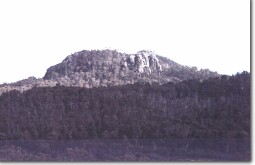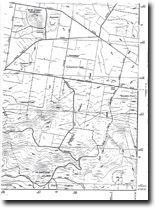The Camels Hump
|
This information has been obtained from the report: Eruption Points of the Newer Volcanic Province of Victoria by Neville Rosengren. This report was published in 1994 and was prepared for the National Trust of Australia (Victoria) and the Geological Society of Australia (Victorian Division). The review of eruption points was based on an earlier unpublished manuscript Catalogue of the post-Miocene volcanoes of Victoria compiled by O P Singleton and E B Joyce (Geology Department, University of Melbourne 1970). |
| 37 22 11S 144 35 51E (external link); 7823-3-4 (Woodend) 872612. 5 km N of Macedon. |  Camels Hump | |
Cameron Drive. | ||
Newham and Woodend. | ||
Public land. | Walking track to summit, outcrop on cliffs and slopes. | |
Type 10: | Other eruption type (namelon). | |
Camels Hump is a steep, craggy dome of lava that forms a prominent and peculiar profile above the surface of Mount Macedon. It is not related to the Macedon igneous rocks (Devonian lavas) but is one of a distinctive group of volcanoes that produced a relatively silica-rich lave (soda trachyte) of high viscosity. These lavas are confined to a small area around Woodend and Trentham and include Hanging Rock and Brock Monument. Averaging 6 million to 7 million years in age, they are the oldest rocks of the Newer Volcanics. At Camels Hump the lava formed a dome or plug at the vent and did not deform into an elongated lava flow. The rock is well exposed as cliffs and screes and in a small disused quarry. Radiometric dating of lava places the age of eruption as 6.14 0.10 million years ago. Small crystals of an unusual mineral (ferroan rectorate) occur in high temperature vesicles in the lava. | ||
1008 m; 60 m. | ||
State: | Camels Hump is an unusual volcano for Victoria both in terms of its form and rock composition. It lies along the time boundary between the Older Volcanics and Newer Volcanics series (Late Miocene) and results from a process of magma differentiation that is restricted to two small areas of the state (Gisborne/Woodend and Daylesford). The volcanoes of these areas constitute a distinctive, small volcanic province that has affinities with provinces in the Eastern Highlands of NSW and Queensland. The Victorian province is the westernmost and most recent of these. The site is an important teaching and reference site to illustrate the influence of lava type on volcano form and is one of the best examples of its type in Victoria. Recent isotopic dating of the rock material has supported earlier (1930’s) evaluation of the age and origin of the volcanic material. | |
References: | Skeats, E.W. & Summers, H.S. (1912). The geology and petrology of the Macedon district. Geological Survey of Victoria Bulletin 24. Edwards, A.B. (1938). The Tertiary volcanic rocks of central Victoria. Quarterly Journal of the Geological Society of London 94, pp. 243-320. Hills, E.S. (1940). The physiography of Victoria (1st edn,) Whitcombe & Tomba, Melbourne. Wellman, P. (1974). Potassium-argon ages on the Cainzoic volcanic rocks of eastern Victoria, Australia. Journal of the Geological Society of Australia 21, pp. 359-376. Birch, W.D. (1988). Specimen minerals. In J.G. Douglas & J.A. Ferguson (eds) Geology of Victoria. Geological Society of Australia, Victorian Division, Melbourne. pp. 482-493. | |
 Camels Hump 7823-3-4 (Woodend) | vro | |
| vro |


